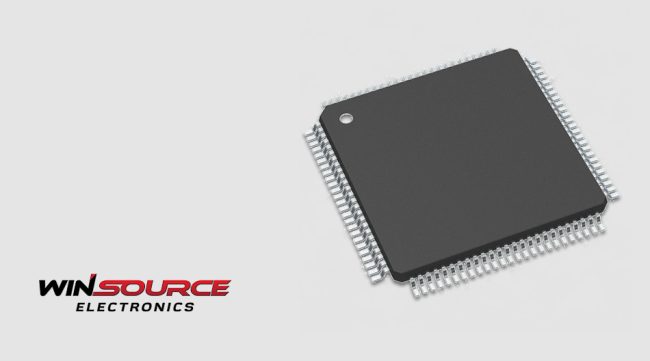
As embedded systems demand higher processing power, greater interface integration, and faster real-time responsiveness, the STM32F765VIT6 stands out as a high-performance solution built around the ARM® Cortex®-M7 architecture. Featuring a dual-precision floating-point unit (FPU), a multi-bus high-speed memory architecture, and a rich peripheral set, it delivers an outstanding balance of computational efficiency and energy performance for complex control, industrial automation, audio-visual processing, and advanced IoT gateway applications.
As one of the key members of STMicroelectronics’ STM32F7 series, this device comes in a 100-pin LQFP package (14 × 14 mm) and supports an industrial temperature range of –40°C to +85°C, ensuring stable, long-term operation in demanding industrial environments.
Processor Architecture and Performance Highlights
- ARM® Cortex®-M7 core operating at up to 216 MHz
- Dual-precision FPU and DSP instruction set extensions for complex signal processing
- Zero-wait Flash acceleration (ART Accelerator) for optimized execution performance
- Multi-bus matrix (AHB/APB) enabling high-speed concurrent access by multiple masters
- Delivers up to 462 DMIPS / 1082 CoreMark
This architecture excels in real-time control, multitasking, and data-intensive signal processing, making it ideal for applications that require both high throughput and deterministic performance.
Key Technical Specifications
Core Architecture | ARM Cortex-M7, 216 MHz, with dual-precision FPU |
Program Memory | 2 MB Flash |
Data Memory | 512 KB SRAM (64 KB ITCM + 128 KB DTCM + 320 KB AXI) |
Communication Interfaces | 4 × USART + 4 × UART, 3 × SPI, 4 × I²C, 2 × CAN, USB OTG HS/FS, SDIO |
Analog Features | 3 × 12-bit ADC, 2 × 12-bit DAC |
Timers | 14 general-purpose + 2 advanced timers |
Memory Expansion | Quad-SPI (QSPI), FMC supporting NOR/NAND/SRAM/PSRAM |
Operating Voltage | 1.7 V – 3.6 V |
Operating Temperature | –40 °C to +85 °C (industrial grade) |
Package Type | LQFP-100 (14 × 14 mm, 0.5 mm pitch) |
System Integration Advantages
- High performance and large memory capacity: Supports advanced algorithms such as graphics rendering, FFT, voice recognition, and motion control.
- Rich peripheral resources: Can directly drive TFT LCDs, Wi-Fi modules, NAND/NOR Flash, and SD cards.
- High-speed communication: Supports USB OTG-HS, CAN FD, and Quad-SPI for fast data exchange.
- Low-power design: Multiple power modes (Sleep, Stop, Standby) with typical current down to 120 µA in Stop mode.
The STM32F765VIT6 strikes a balance between processing capability, peripheral integration, and energy efficiency, making it well-suited for industrial control and communication systems that demand both high performance and reliability.
Typical Application Scenarios
Industrial Automation | PLC controllers, high-speed motion control boards, real-time edge gateways |
Medical Devices | Data acquisition units, diagnostic interface modules, portable analyzers |
Intelligent Transportation | Multi-sensor fusion systems, V2X front-end controllers |
Voice and Image Processing | Embedded voice recognition, audio signal processing, LCD display systems |
Advanced IoT Gateways | Multi-protocol edge nodes, smart relay controllers, data gateways |
Development Resources and Ecosystem Compatibility
- Supports STM32CubeMX configuration and the STM32CubeF7 HAL driver library
- Compatible with FreeRTOS, Zephyr, and other mainstream RTOS platforms
- Works with ST-LINK debuggers and STM32F7 Discovery Kits
- Pin- and software-compatible with the STM32F4/F7 families for easy migration and code reuse
With its mature ecosystem, engineers can rapidly complete system design, peripheral debugging, and power optimization using familiar ST development tools.
Design Recommendations
- Optimized TCM usage:Map interrupt routines and critical algorithms (e.g., FFT) to ITCM/DTCM for real-time performance.
- Peripheral expansion:Use the FMC interface for external SRAM, LCD controllers, or NAND Flash.
- USB applications: Prefer OTG-HS mode for high-speed peripherals such as cameras and USB drives.
- Power optimization:Configure low-power and wake-up modes via STM32CubeMX.
- EMC considerations:In mixed-signal or RF environments, maintain ground separation and signal integrity in PCB layout.
These practical guidelines help balance performance, power efficiency, and reliability during system development.
Combining a 216 MHz Cortex-M7 core, 2 MB Flash, 512 KB RAM, and an extensive set of communication and control interfaces, the STM32F765VIT6 delivers exceptional system-level integration for industrial control, signal processing, and edge computing applications. Its long-term availability, robust ecosystem, and proven stability make it an ideal choice for high-end embedded platforms where both performance and reliability are critical.
To explore more component specifications, packaging models, and inventory availability, please visit the WIN SOURCE official website.
© 2025 Win Source Electronics. All rights reserved. This content is protected by copyright and may not be reproduced, distributed, transmitted, cached or otherwise used, except with the prior written permission of Win Source Electronics.

COMMENTS